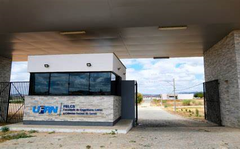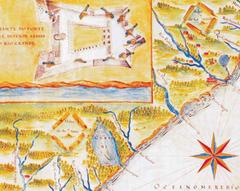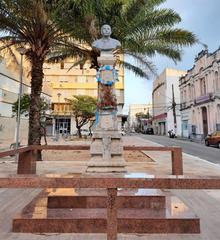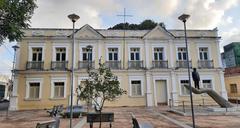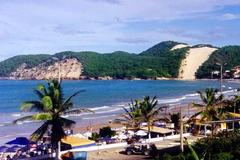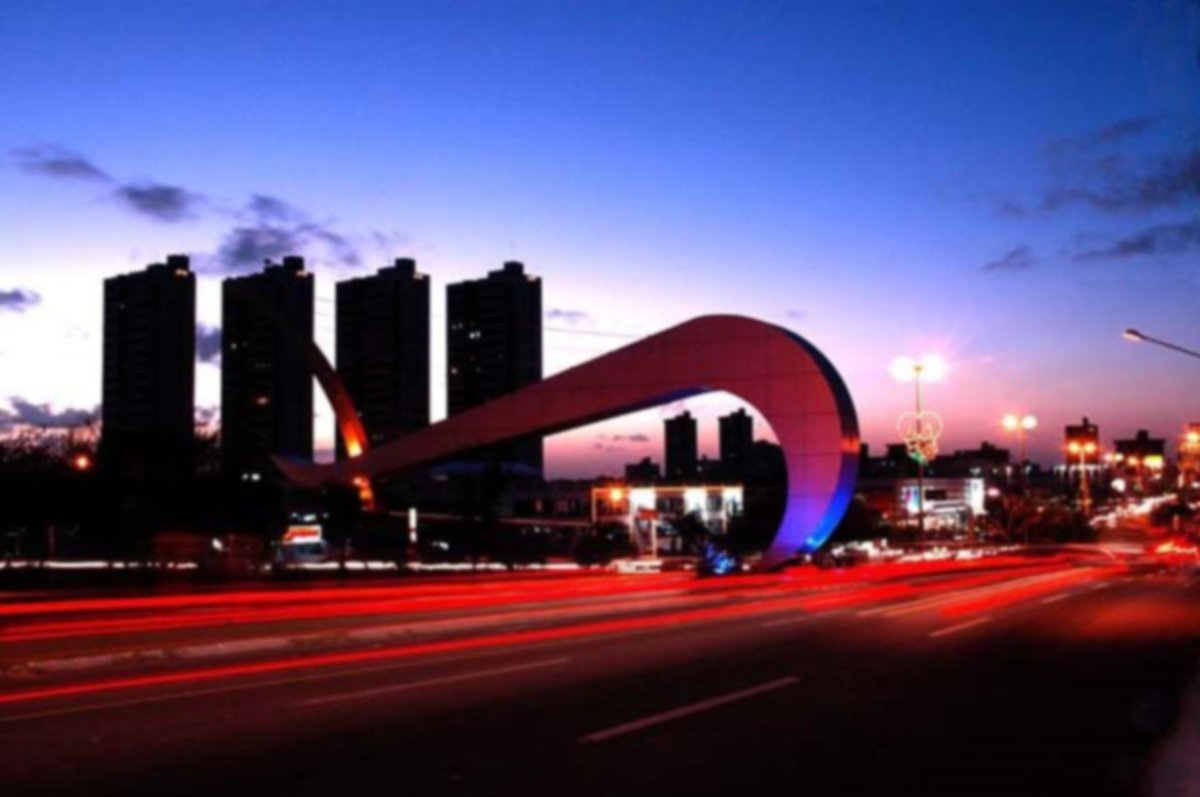
Arco do Sol, Natal, Brazil: Visiting Hours, Tickets, and Historical Significance
Date: 14/06/2025
Introduction
Arco do Sol—translated as the “Arch of the Sun”—remains a defining symbol of Natal, Brazil, encapsulating the city’s enduring relationship with the sun, sea, and progressive urban design. Originally an iconic monument and now a major avenue, Arco do Sol is both a historical reference point and a vital urban corridor connecting the city center to the stunning southern beaches such as Ponta Negra and Pirangi. Although the original metallic arch was dismantled in 2011 due to structural concerns, its legacy lives on in the avenue that bears its name and the continued cultural relevance of its location.
This guide provides a comprehensive look at Arco do Sol’s history, architectural and cultural symbolism, practical visitor details, and its ongoing significance in Natal’s tourism and community life. Whether you are a history enthusiast, beach lover, or someone seeking to immerse in local festivities, Arco do Sol is a gateway to experiencing the true spirit of the “City of the Sun.”
Contents
- History and Evolution of Arco do Sol
- Architectural and Urban Significance
- Cultural Symbolism and Local Identity
- Visiting Information: Hours, Tickets, Accessibility, and Travel Tips
- Arco do Sol’s Role in Tourism and Economic Development
- Integration with Natal’s Historical Context
- Community Engagement and Environmental Initiatives
- Visitor Experience and Practical Tips
- Nearby Attractions
- Safety and Accessibility Considerations
- Frequently Asked Questions (FAQ)
- Conclusion and Visitor Recommendations
- Sources and Further Reading
History and Evolution of Arco do Sol
Arco do Sol originally stood as a metallic arch located on Avenida Engenheiro Roberto Freire, a principal thoroughfare leading to Natal’s southern beaches. Designed by architect Felipe Bezerra, the monument was unveiled in the early 2000s to represent Natal’s identity as the “City of the Sun.” Its futuristic arch symbolized the sunrise over the Atlantic and the city’s coastal vibrancy. Over time, severe corrosion from the coastal climate compromised its structure, and it was dismantled in 2011 for safety reasons (natal.rn.gov.br, brechando.com). Today, the site remains a symbolic gateway to the city’s beach district, with the avenue still central to Natal’s infrastructure and community life.
For an expanded historical overview, see (thetravel.com).
Architectural and Urban Significance
The original monument was noted for its minimalist, sun-inspired design—silver-colored aluminum plates reflected sunlight, while a golden-hued steel support evoked sun rays. Steel cables stabilized the structure, referencing the city’s maritime roots. The arch’s presence marked a transition in Natal’s urban development, contrasting with the city’s colonial heritage and signaling a move toward modern aesthetics (natal.rn.gov.br).
Even after its removal, the avenue maintains landscaped medians, pedestrian walkways, and bike lanes, drawing on inspirations from Brazilian urbanists such as Roberto Burle Marx (britannica.com). The corridor offers panoramic views of the Atlantic, sand dunes, and native vegetation—making it both a scenic and functional route for locals and tourists.
Cultural Symbolism and Local Identity
Arco do Sol’s name and design celebrate Natal’s sunny disposition and its beach-centric lifestyle. The avenue is particularly lively during major festivals—especially Christmas—when it is adorned with illuminated decorations and hosts parades and cultural events, reinforcing local traditions and community bonds (thetravel.com).
Visiting Information
Visiting Hours
- Arco do Sol Avenue: Open to the public 24 hours a day, year-round.
Tickets
- Avenue Access: Free of charge.
- Nearby Attractions: Some sites, like Fortaleza dos Reis Magos, may charge an entry fee (typically R$10–R$30).
Accessibility
- Public Transport: Multiple bus lines, taxis, and ride-hailing services (e.g., Uber) provide easy access (mibitacoradeviajes.com.ar).
- Private Vehicles: The avenue is wide, with ample parking and clear signage.
- Pedestrian and Cyclist Facilities: Paved walkways and dedicated bike lanes make the area accessible for all mobility levels.
- People with Disabilities: Sidewalks are generally level and equipped with curb cuts, though some uneven areas may exist (brazilcityguides.com).
Travel Tips
- Visit early morning or late afternoon for optimal lighting and cooler temperatures.
- Peak seasons (Christmas, New Year) bring more traffic and vibrant street markets.
- For a fuller experience, consider exploring the corridor on foot or by bicycle.
Arco do Sol’s Role in Tourism and Economic Development
The avenue is vital to Natal’s tourism, linking hotels, resorts, and recreation areas to the city’s beaches. Tour operators use the route for excursions such as dune buggy rides and river trips (travelmag.com). Growth along the avenue has led to new restaurants, shops, and entertainment venues, stimulating local employment and economic activity.
Integration with Natal’s Historical Context
Arco do Sol connects modern developments to Natal’s historical core, lying near landmarks like the Natal Historic Center, Câmara Cascudo Museum, and Fortaleza dos Reis Magos (travelmag.com). Its position enhances the city’s cultural circuit and provides easy access to both past and present attractions.
Community Engagement and Environmental Initiatives
The corridor is a hub for community interaction, with outdoor activities, public art, and festivals (britannica.com). Environmental initiatives promote the preservation of native flora and fauna, complemented by regular clean-up events and educational programs for local stewardship.
Visitor Experience and Practical Tips
- Best Time to Visit: Dry season (September–February) offers sunny skies; festivals add a vibrant atmosphere.
- Photography: Early morning, late afternoon, and festival nights are ideal for photos.
- Safety: The area is generally safe, but standard urban precautions apply—avoid isolated areas at night, keep valuables secure, and use reputable transportation (Travelsafe Abroad).
- Amenities: Cafés, shops, hotels, and public restrooms are abundant along the avenue (audiala.com).
Nearby Attractions
- Ponta Negra Beach: Famous for its scenic beauty and the Morro do Careca dune (wildtrips.net).
- Natal’s Northern Gateway (Pórtico): Another significant monument marking the city’s entrance (brechando.com).
- Forte dos Reis Magos: A 16th-century fort with guided tours and panoramic views.
- Cajueiro de Pirangi: The world’s largest cashew tree.
- Historic Downtown Natal: Museums and colonial architecture.
Safety and Accessibility Considerations
- Safety: Remain in well-populated areas, avoid displaying valuables, and take extra caution at night (Travelsafe Abroad).
- Health: Use sunscreen and drink bottled water; protect against mosquito-borne diseases with repellent.
- Emergency Numbers: Police: 190, Medical Emergencies: 192, Tourist Police: Available in visitor zones.
- Women Travelers: Travel in groups and avoid isolated areas after dark.
Frequently Asked Questions (FAQ)
Q: Is Arco do Sol still standing?
A: The original monument was dismantled in 2011, but the avenue and its location remain significant.
Q: Are there any visiting hours or ticket fees?
A: The avenue is open 24/7 with no admission fee. Some nearby attractions may charge for entry.
Q: How do I get there?
A: By bus, taxi, ride-sharing, or private car. The avenue is highly accessible.
Q: What are the best nearby attractions?
A: Ponta Negra Beach, Forte dos Reis Magos, the northern gateway Pórtico, and Natal’s historic downtown.
Q: Is the area accessible for people with disabilities?
A: Yes, with mostly level sidewalks, curb cuts, and accessible parking. Some uneven pavement may exist.
Conclusion and Visitor Recommendations
Arco do Sol remains an emblematic feature of Natal’s urban and cultural landscape, representing the city’s sunny and welcoming spirit. While the monument itself is gone, the avenue provides unparalleled access to Natal’s beaches, festivals, and historic sites. Visitors are encouraged to explore on foot or by bike, enjoy local amenities, and immerse themselves in the festive atmosphere—especially during peak seasons. Pair your visit with nearby attractions for a comprehensive experience of Natal’s unique blend of history, nature, and modern urban life.
For up-to-date guides, maps, and personalized travel tips, download the Audiala app. Stay informed about events and insider recommendations to make the most of your visit to the City of the Sun.
Sources and Further Reading
- Exploring Arco do Sol in Natal: History, Visiting Hours, Tickets, and Nearby Attractions
- Exploring Arco Do Sol: History, Location, and Visitor Information for Natal’s Iconic Monument
- Arco Do Sol de Ponta Negra nunca mais vai voltar
- Arco Do Sol Visiting Hours, Tickets & Travel Guide | Natal Historical Sites
- Arco do Sol Natal: Visiting Hours, Tickets, and Travel Tips for This Iconic Landmark
- Things to Do in Natal, Brazil – Destinationless Travel
- Tourism Guide to Natal in Rio Grande do Norte
- Britannica: Brazil Cultural Life
- Travelmag: Things to Do in Natal
- Mibitacoradeviajes: Guía útil para viajar a Natal
- Brazil City Guides: Natal Travel Guide
- Wildtrips: What to Visit in Natal
- Audiala: Travel Guide to Natal
- Travelsafe Abroad: Brazil

